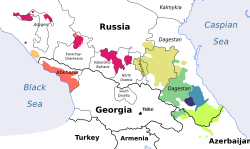| Lezgic | |
|---|---|
| Geographic distribution | |
| Linguistic classification | Northeast Caucasian
|
| Proto-language | Proto-Lezgic language |
| Subdivisions | |
| Language codes | |
| Glottolog | lezg1248 |
 Lezgic | |
The Lezgic languages (also Lezgian or Lezghian) are one of seven branches of the Northeast Caucasian language family. Lezgin and Tabasaran are literary languages. Khinalug may either be Lezgic or an independent branch of the Northeast Caucasian family.

